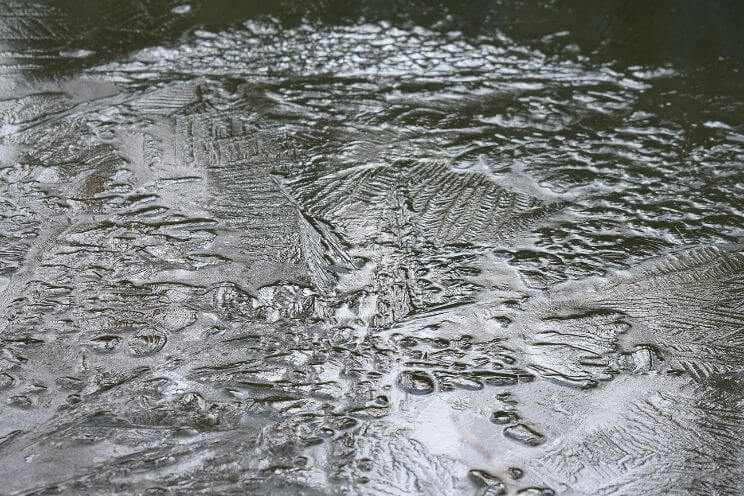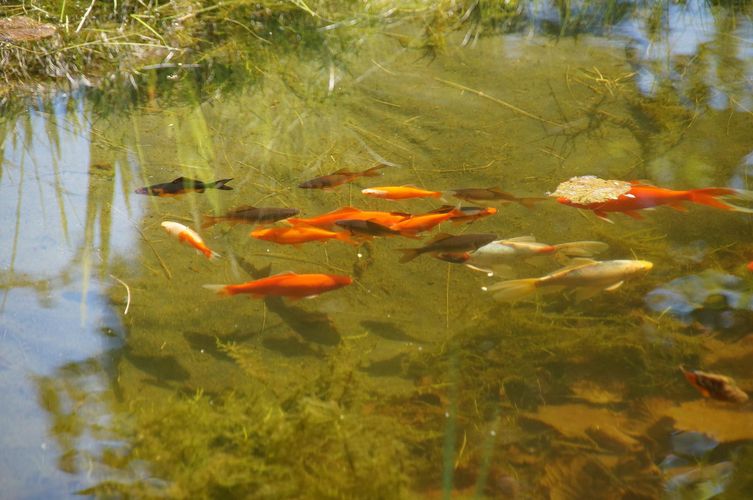Towards the end of the year, you may be in a situation where you are wondering if adding goldfish to your pond now is a good idea, or if you should hold fire until next year.
Why should we be concerned about this topic? Is it possible to add goldfish to your pond in winter? Why may it be a bad idea?
In this article, we aim to answer these questions.

Should you add fish to a pond in winter?
Ideally, you should not be adding any fish to your pond during winter – the reason for this is because the low temperatures are difficult to adjust to within a quick time frame.
Naturally, when winter sets in, fish will have weeks of a slow, gradual temperature drop, which their bodies have plenty of time to adjust to. By introducing your fish suddenly in the dead of winter, they don’t have this time to adjust.
Unlike us humans, who consume large amounts of energy all the time to keep our bodily functions going normal, fish have different states of energy consumption, and these correspond with the temperature of the surrounding environment.
In winter, fish enter Torpor, which allows them to slow down their body functions and preserve energy.
Torpor alters the fish’s internal functions and alters its lifestyle.
However, to become torpid takes time, and a gradual adjustment to temperatures, often taking a few days or even weeks to set in for some fish species.
- In short, we recommend the latest time of year to add fish to a pond is in the early fall, around the beginning of October.
Any later than this and the temperature drops, especially at night time, are too much for a fish to adjust to, especially if it has been brought outside from living in an indoor tank.
We then recommend against adding any fish until March, when temperatures are more stable; April may be even better depending on your location.

What happens if you introduce a fish to a pond in winter?
Depending on how this is done, it can have varying levels of success or severity.
If a fish is quickly introduced to freezing temperatures it is not used to, it will become shocked.
All animals will become stunned if they are hit with too harsh a temperature change too fast. You will know if a fish is stunned as it will stop moving and will either sink or float to the surface.
If your fish does this for longer than a minute, then it’s probably best to pull them out and try slowly bringing the temperature back, as they are not ready for the temperature shock.
You have to be very careful when playing with temperatures like this as it is an easy way to kill your goldfish.
Everything should be slow and methodical – acclimation times can take hours sometimes, but it is worth waiting instead of rushing it and killing your fish.
A fish that has lived in a tank and is suddenly cast in waters below 10C / 50F will not fare so well, since they haven’t had the time to adjust their bodies in preparation for going torpid.
Can you transfer fish from another pond in the winter?
Although we don’t advise moving your fish or handling them during winter, if you must move them, it is possible to move them from one pond to another, accepting the fact they are the same or of a similar temperature.
Treat it the same as any other acclimation process, but give a little more time than you normally would.
- We recommend at least 45 minutes of acclimating time during colder months if possible.
Also, make sure the pond you move them to is well insulated and suitable for winter.

How to know if it is too cold to add fish to a pond
By using a thermometer to test the temperature of the water, you can gauge if it is a good idea or not to move your fish outside.
Typically, any temperatures below 10C / 50F, we recommend against moving your fish outside. This is because below this temperature the fish change in physiology and torpor begins.
We also recommend against temperature changes higher that vary more than 10C as this is too much of a change for a fish to adjust to in an hour or so; acclimating could take a whole day, or longer.
Say your fish are in a tank that is 27C / 80 F, it would be unwise to move them to a pond that is less than 15C / 59F in temperature. We would recommend slowly cooling their tank down to 20C / 68F before making this move; do this over a period of hours or maybe a few days.
When introducing them, let them acclimate for about an hour and keep checking on them too, making sure they are okay and acting normally.
When is the best time to add fish to a pond?
The best time of year to be adding or moving fish is in the warmer months, late spring, summer and very early autumn is okay.
For temperate climates, late march until early October is the ideal range to add fish to a pond, with the best months being May, June, July and August.
However, if you live somewhere that has very intense summer heat waves like California, then August may not be the best time to be working on your pond, and perhaps April or May would be a better time to add the fish.
If you live in a tropical climate and have a pond, then any time of year is fine. Just be sure the pond is secure for the harsh heat of the dry season and has proper drainage to prevent flooding in the rain season.
In essence, the best time of year to add fish to a pond or move pond fish around is when the weather is most stable, and lacks massive fluctuations or intense temperature gradients.

How to introduce fish to a pond during winter?
If you are in a last resort scenario and must move your fish outside during autumn or winter, then there are ways to do it, but it isn’t easy and can be expensive to do.
The aim is to slowly adjust your fish to the natural outdoor winter temperatures over a period of a few days or weeks.
This is done by taking measures to either warm up the pond, or insulate it so much that very little heat escapes.

Heating your pond in winter
It is entirely possible to heat up your pond during winter, but this can be expensive to do as it drains electricity and some heaters can be expensive.
You can use either a glass or titanium aquarium heater to do this.
A titanium heater will be vastly more effective at warming up your pond, but it will be much more expensive than a glass heater, and requires a separate thermostat.
Combining the use of a glass heater with a pond cover will greatly increase the effectiveness; it will heat your pond much faster and maintain the heat for much longer.
For a pond cover, a few different materials can be used, netting, plastic tarp or wood.
The best insulating material for a pond cover however, is coralite, it is a form of rigid plastic, it is cheap, widely available and can be cut into many shapes and sizes.
It is an excellent insulator because of its natural heat absorption and the fact it contains an air gap between the layers.
The material is however, rather light and should be weighted, lest a strong wind picks it up and takes it away.
If you use a glass heater, then get the wattage that closest matches the amount of litres your pond holds. Sometimes the largest size may still not be high enough, but it should still suffice.
If you need to, you can even connect multiple heaters, but again, as mentioned, this adds more cost, making this a very expensive process.
Without a cover, this will be even more expensive as most of the heat will be lost through the surface.
You want to heat your pond as close to room temperature as possible, if your fish have been kept in an indoor tank.
Acclimating pond fish in winter
Once you have heated your pond and properly insulated it, then you can acclimate your fish. Keep a close eye on the temperature and add your fish in bags or buckets.
- Float them at the top and gradually add pond water to them, getting them used to the temperature and different water chemistry.
- Do this for about an hour before adding them, pay close attention to their behaviour to look for signs of shock or poor reaction to the acclimation, such as losing balance, swimming on side or becoming completely motionless.
If they still seem to be in poor condition after a long period, then try acclimating them for longer, raising the temperature of the pond, or in extreme cases, taking them back inside.
- After an hour or more once they have acclimated, release them into the pond and keep a close eye on them over the next few days.
- As the days go by, gradually reduce the temperature on the heaters, until they are no longer needed, perhaps by 1 or 2 degrees per day.
This may take a week two, but by then, your goldfish will have had enough time to properly adjust their bodies for the cold winter, and will be properly acclimatised to their new environment.
- Remove the heaters and continue to keep a close eye on your fish.
- Then proceed with your normal winter care. You can check out our guide on pond care in winter for help with this.
